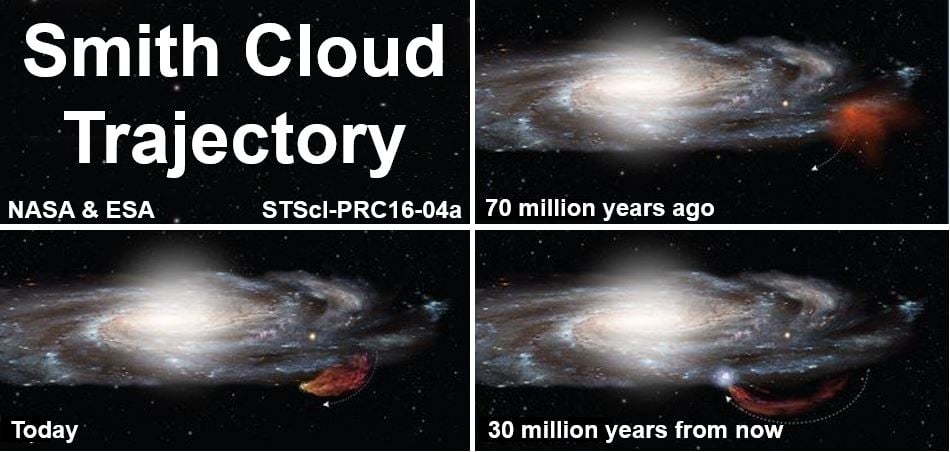A mega gas cloud that is whizzing towards the Milky Way at 700,000 miles per hour (1,126,540 km/h) will probably become a giant star factory producing about two million new suns when it finally crashes into our galaxy, say scientists from the University of Notre Dame in Indiana, along with colleagues from other centres in the USA and Japan.
Astronomers were able to make this discovery after they worked out what the chemical composition of the Smith Cloud was. The cloud was first discovered by Gail Bieger (née Smith) in 1963, an astronomy student at Leiden University in the Netherlands.
The astronomers wrote about their study and findings in the academic journal Astrophysical Journal Letters (citation below).
 This graphic shows where the Smith Cloud is as seen from Earth, if it were visible. (Image: news.nd.edu. Credit: A. Mellinger)
This graphic shows where the Smith Cloud is as seen from Earth, if it were visible. (Image: news.nd.edu. Credit: A. Mellinger)
Since scientists discovered the Smith Cloud, which is racing towards us at an incredible 193 miles per second (310 km/s), the major challenge has been to determine its composition, which would give us a better idea where it came from.
Smith Cloud has Sun-like elements
Nicolas Lehner, Research Associate Professor in Astrophysics at the Department of Physics at the University of Notre Dame, Indiana, and colleagues now believe that the cloud has elements similar to those found in our Sun, which means it probably originated in the outer edges of the Milky Way, and not in intergalactic space as several scientists had speculated.
The Smith Cloud is the only cloud travelling at ultra-high speed for which its orbit is well-determined, thanks to data gathered and analyzed from radio telescopes such as the Green Bank Telescope (GBT).
This starless gas cloud is forecast to collide with the Milky Way disk within the next thirty million years. If it were visible, it would have an apparent width of around thirty times the diameter of the Moon from tip to tail.
Cloud contains heavier elements
Researchers had long believed that the Smith Cloud might be a starless galaxy or gas cloud making its way to the Milky Way from intergalactic space. If it were, its composition would be mainly of helium and hydrogen, and not the heavier elements made by stars.
 This illustration depicts how the astronomers used the Hubble Space Telescope to view 3 distant galaxies through the Smith Cloud – a technique that helped them determine the composition of the cloud. (Image: news.nd.edu)
This illustration depicts how the astronomers used the Hubble Space Telescope to view 3 distant galaxies through the Smith Cloud – a technique that helped them determine the composition of the cloud. (Image: news.nd.edu)
Prof. Lehner and colleagues used the Hubble Space Telescope to determine for the first time how much of the Smith Cloud is made up of heavier elements relative to hydrogen.
They used Hubble’s Cosmic Origins Spectrograph and observed the ultraviolet light from the bright cores of three active galaxies located light years beyond the cloud. Some of the light from those galaxies is absorbed by the Smith Cloud in a very small wavelength range.
By measuring the dip in brightness of these galaxies, they could estimate the Smith Cloud’s chemical makeup.
The scientists looked specifically for absorption from the sulfur, which is a good indicator of what the levels of many heavier elements within the cloud might be.
Team leader, Dr. Andrew J. Fox, an astronomer at STScI (Space Telescope Science Institute) in Baltimore, Maryland, the scientific home of the Hubble Space Telescope, said:
“By measuring sulfur, you can learn how enriched in sulfur atoms the cloud is compared to the Sun.”
 This graphic shows the Smith Cloud’s trajectory, falling into the Milky Way galaxy. (Image: adapted from news.nd.edu)
This graphic shows the Smith Cloud’s trajectory, falling into the Milky Way galaxy. (Image: adapted from news.nd.edu)
Dr. Fox and colleagues compared Hubble’s sulfur measurements against the hydrogen measurements made by the Green Bank Telescope.
Smith Cloud rich in sulfur
They found that the Smith Cloud is as rich in sulfur as the outer disk of the Milky Way, a region in our galaxy approximately 40,000 light years from its centre and roughly 15,000 light years farther out than our Sun and solar system are.
This means that the cloud was polluted by material from stars, which would not have happened had it been pristine hydrogen from outside the galaxy.
In fact, the Smith Cloud appears to have had an intimate relationship with our galaxy, but was somehow flung out from the outer Milky Way disk approximately seventy million years ago, and is now making its way back to the disk like a boomerang.
 Prof. Nicolas Lehner. On his university webpage, he wrote: “My research focuses on understanding the physical processes that drive and regulate the growth of galaxies.” (Image: news.nd.edu)
Prof. Nicolas Lehner. On his university webpage, he wrote: “My research focuses on understanding the physical processes that drive and regulate the growth of galaxies.” (Image: news.nd.edu)
The researchers think the Smith Cloud has enough gas to create two million suns when it collides with the Milky Way disk.
Prof. Lehner said:
“We have found several massive gas clouds in the Milky Way halo that may serve as future fuel for star formation in its disk, but, for most of them, their origins remain a mystery.”
“The Smith Cloud is certainly one of the best examples that shows that recycled gas is an important mechanism in the evolution of galaxies.”
Citation: “ON THE METALLICITY AND ORIGIN OF THE SMITH HIGH-VELOCITY CLOUD,” Andrew J. Fox, Nicolas Lehner, Felix J. Lockman, Bart P. Wakker, Alex S. Hill, Fabian Heitsch, David V. Stark, Kathleen A. Barger, Kenneth R. Sembach, and Mubdi Rahman. The Astrophysical Journal Letters, Volume 816, Issue 1, article id. L11, 6pp. DOI: 0.3847/2041-8205/816/1/L11. 30 Dec 2015.
